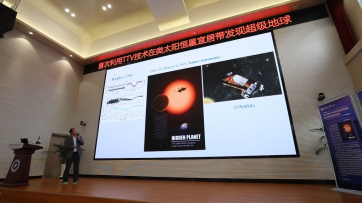
The ancient question of whether life exists beyond Earth continues to fascinate us. A significant discovery now brings us closer to an answer. An international team, led by Chinese scientists from the Yunnan Observatories, has used a clever method called transit timing variation (TTV) to find a promising planet. They detected a “super-Earth”, named Kepler-725c, orbiting within the habitable zone of a sun-like star, Kepler-725.
1.1. What makes Kepler-725c possible for supporting life?
A Strong magnetic field.
B Host star’s youth.
C Close distance to Earth.
D Habitable zone position.
解析:选D。 D 细节理解题。第一、二段原文明确该行星位于宜居带(“within the habitable zone—where temperatures might allow liquid water”),这是支持液态水(生命的关键要素)存在的关键条件。故选D。
2.2. The method of transit timing variation(TTV) fundamentally measures ______.
A star brightness changes
B planet orbital shifts
C magnetic activity levels
D light-year distances
解析:选B。B 推理判断题。原文中通过时钟比喻说明TTV的原理,并且进一步解释“By carefully measuring tiny timing changes in the transits of another known planet in the system, the gas giant Kepler-725b (orbiting every 39.64 days), scientists inferred Kepler-725c’s presence, mass, and orbit.”通过仔细测量该系统中另一颗已知行星——气体巨星开普勒-725b(每39.64天绕轨道运行一次)的微小时间变化,科学家推断出开普勒-725c的存在、质量和轨道。由此可知,这个方法的本质是测量另一已知行星的轨道周期变化。故选B。
3.3. What advantage does TTV have over traditional methods?
A Detecting older stars.
B Finding distant solar systems.
C Locating small habitable planets.
D Measuring precise planet mass.
解析:选C。C 细节推理题。根据第四段中的“The TTV technique is especially powerful for finding smaller, potentially Earth-like planets with longer orbits in habitable zones.”可知,TTV技术在寻找更小的、可能与地球类似的、轨道更长、位于宜居带的行星方面尤其强大。故选C。
4.4. The research team plans to ______.
A develop new telescopes
B confirm planet conditions
C study only Kepler-725b
D abandon current methods
解析:选B。B 推理判断题。根据最后一段中的“They will combine TTV with other methods like transmission spectroscopy to see if Kepler-725c truly has Earth-like conditions.”可知,他们将把TTV与透射光谱等其他方法结合起来,看看开普勒-725c是否真的具有类似地球的条件。对应B项的“确认该行星的条件”。故选B。